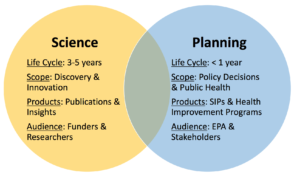LADCO participates in air quality research projects to improve our understanding of air pollution science in the Great Lakes region.
We partner with federal research labs, universities, non-governmental organizations, and private companies to design and execute air quality research projects. Identifying and addressing knowledge gaps in the science of air pollution, finding new ways to gather and analyze atmospheric data, and improving the interface between science and policy are the types of projects in which we typically engage.

LADCO engages in both basic and translational research projects. Our basic research projects generally focus on improving our understanding of the physical and chemical drivers of air pollution, enhancing how we simulate pollution emissions processes, and developing new data analysis techniques. We are also involved as collaborators on applied research projects to represent the perspectives of air quality planning agencies. In these translational projects, LADCO works in the interface between science and policy to translate communication and objectives across the two spaces.
Click the study name below to expand/collapse the menu for highlights of current and recent air quality projects in which LADCO has been involved.
Ozone Projects
This project by Georgia Tech was designed to support ozone NAAQS attainment planning in the Great Lakes region by estimating the impacts of nitrogen oxides (NOx) and volatile organic compounds (VOC) emissions changes on ozone (O3) concentrations. The project objective was to estimate the changes in surface O3 concentrations in response to reducing the emissions of NOx and/or VOC from different inventory sectors. Its goal was to identify optimal O3 reduction strategies for each of the nonattainment/maintenance areas in the LADCO region.
The project used version 7.10 of the Comprehensive Air Quality Model with Extensions (CAMx) equipped with High-order Decoupled Direct Method (HDDM) to simulate the first and second order sensitivity coefficients of O3 concentrations to the emissions of NOx and VOCs and conducted further analysis to estimate the changes in O3 concentrations in response to reductions in those precursor emissions in the LADCO region.
The 2017 Lake Michigan Ozone Study (LMOS 2017) was a collaborative, multi‐agency field study of ozone chemistry and meteorology along the Wisconsin‐Illinois Lake Michigan shoreline using a combination of aircraft, ground‐based and ship‐based measurements. The Lake Michigan region has persistently high ozone concentrations that are impacted by complex meteorology and significant transport of pollutants. The overall goal of the study was to better understand ozone formation and transport around Lake Michigan to assist researchers and air quality managers who study, predict, and manage ozone concentrations in the region.
The 1991 Lake Michigan Ozone Study (LMOS 1991) was the first major air pollution and meteorology field campaign that targeted the western shores of Lake Michigan. The document archive for LMOS 1991 is available below.
Regional Haze Projects
In 1999, EPA promulgated the Regional Haze Rule (RHR) to improve and protect visibility in the nation’s national parks and wilderness areas. Because the fine particles that impair visibility can travel for hundreds of miles, the RHR requires all 50 states to work together to develop strategies to reduce their emissions and impacts on the parks. Under the RHR, states must make reasonable progress toward the goal of “no manmade impairment” in national parks and wilderness areas by the year 2064.
For the second Regional Haze Planning period, we are working with our member states to demonstrate reasonable progress toward this goal for the period 2018-2028.
Visit the LADCO Second Implementation Period Technical Support Page…
In 2000, the states of Illinois, Indiana, Michigan, Ohio, and Wisconsin formed the the Midwest Regional Planning Organization (MRPO) to address issues related to the federal Regional Haze program, and pollutants, such as fine particles, that contribute to regional haze. Key documents and the full MRPO document archive from this first regional haze planning period are provided here.
Midwest RPO Regional Haze Summary Report (Feb 2008)
Midwest RPO Reasonable Progress Factor Analysis (July 2007)
Complete MRPO Phase I Regional Haze planning document archive:
Particulate Matter Projects
Emissions Projects
Other Projects
Interested in collaborating with LADCO on research projects?
LADCO both funds projects and participates as a collaborator on sponsored-research projects. Keep an eye on LADCO’s Request for Proposals page for funding opportunities with LADCO.
Contact the LADCO Executive Director about partnering on air quality research and applications projects with LADCO.


